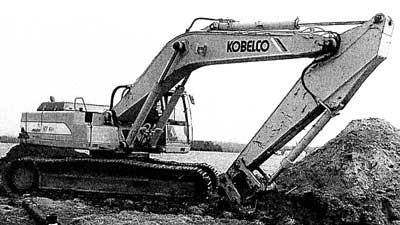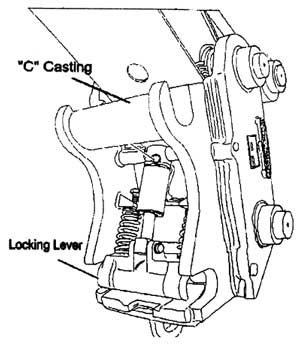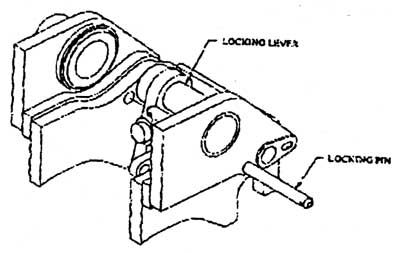Laborer Dies After Being Struck by Detached Excavator Bucket
Wisconsin Case Report 03WI003
Summary
A 39-year-old laborer (the victim) died when he was struck by the bucket of a hydraulic excavator. The victim was part of a construction company crew that was trenching for sewer and water lines in a new development, using an excavator equipped with a quick-disconnect bucket-coupler to excavate the trench. The victim had entered the trench to measure the depth, while the excavator operator switched buckets from a narrow bucket to a larger one. After he attached the larger bucket, the operator raised the bucket to work on an adjacent trench. The bucket suddenly disconnected from the bucket arms, fell to the edge of the trench and rolled into the hole onto the victim. The operator immediately saw the victim was injured, and called 911 from a cell phone. He used a chain to pull the bucket away from the victim with the backhoe. EMS responders and Med Flight responders arrived within several minutes. The victim was pronounced dead at the scene.
The FACE investigator concluded that, to prevent similar occurrences, employers should:
- install and maintain positive locks on quick-disconnect equipment according to manufacturers’ specifications and recommendations.
- train excavator operators to conduct visual and operational checks after changing attachments.
- prohibit workers on foot from entering the swing area of hydraulic excavators until they signal the operator to shut down the machine and receive acknowledgement from the operator.

|
|
Figure 1. Photo of Excavator Involved in Incident
|
Introduction
On April 2, 2003, a 39-year-old male laborer (the victim) died after he was struck by the bucket of a hydraulic excavator. The Wisconsin FACE field investigator learned of the incident from the Area OSHA office on the day after it occurred, and initiated an investigation on August 25, 2003. The employer declined to participate in the investigation. The incident scene was changed soon after the incident, and equipment was moved so a site visit was not conducted. The investigator reviewed official reports. The content of this report is based on the information from evidence presented in the official reports.
The employer was an excavating contractor that had been in business for over fifty years. At the time of the incident, the company was installing water and sewer lines in a new 642-acre housing and commercial development. On the day of the incident, the company had five employees working at the site. The victim had been employed at the company for about 13 years prior to the incident.
The age of the bucket excavator involved in this incident is unknown. Two buckets were being used on the day of the incident; the excavator operator used the larger bucket to dig the top portion of a trench, and would switch to the narrower one when digging the bottom of the trench.
A retrofit kit for the coupler that attached the buckets to the excavator arm had been sent to the employer two years before the incident, but was not installed on the excavator. The coupler manufacturer recommended installation of the free retrofit items to prevent the locking lever from opening when the bucket was used. It was the excavator owner’s responsibility to modify the coupler by drilling holes to accommodate the mechanical locking pin. To change a bucket with the retrofit in place, the operator must manually insert the locking pin and two lynch pins in the coupler before and after each bucket change. The manufacturer also recommended a series of bucket maneuvers that should be performed close to the ground and away from all personnel after each bucket change, to test the connection.

|
|
Figure 2. Diagram of coupling mechanism showing original locking lever design.
|

|
|
Figure 3. Diagram of locking pin placement from retrofit kit.
|
Back to Top
Investigation
On the day of the incident, the excavator operator was using the excavator to dig trenches for water and sewer lines. He dug a trench to a depth of about nine feet at 2:15 PM, then the victim entered the trench to precisely measure the depth. There was no trench box or other shoring materials in place in the trench.
The workers had installed about ninety feet of storm sewer and 200 feet of water line on that day, with the buckets being switched about thirty times prior to the incident. After switching a bucket, the operator would usually check the coupler connection by keeping the bucket close to the ground and away from other workers while curling it inward and outward. The operator had not been instructed to visually inspect the connection, so he seldom did. The workers were aware that the bucket occasionally became detached from the excavator and fell, but it is unknown what actions the company took to prevent that from occurring.
While the victim was in the freshly-dug trench, the excavator operator switched buckets from a narrow bucket to a larger one. After he attached the larger bucket, the operator raised the bucket to work on an adjacent trench. The bucket suddenly disconnected from the bucket arms, fell to the edge of the fresh trench and rolled into the hole onto the victim. The operator immediately saw the victim was injured, and called 911 from a cell phone. He used the excavator and a chain to pull the bucket away from the victim. EMS responders and Med Flight responders arrived within several minutes. The victim was pronounced dead at the scene.
Cause of Death
The official cause of death was major blunt force trauma to head and chest.
Recommendations/Discussion
Recommendation #1: Employers should install and maintain positive locks on quick-disconnect equipment according to manufacturers’ specifications and recommendations.
Discussion: A retrofit kit for the coupler that attached the buckets to the excavator arm had been sent to the employer two years before the incident, but was not installed on the excavator. The coupler manufacturer recommended installation of the free retrofit items to prevent the locking lever from opening when the bucket was used. It was the excavator owner’s responsibility to modify the coupler by drilling holes to accommodate the mechanical locking pin. To change a bucket with the retrofit in place, the operator must manually insert the locking pin and two lynch pins in the coupler before and after each bucket change. This would have prevented the bucket from detaching from the arm.
Recommendation #2. Employers should train excavator operators to conduct visual and operational checks after changing attachments
Discussion: The manufacturer recommended a series of bucket maneuvers that should be performed close to the ground and away from all personnel after each bucket change, to test the connection. These maneuvers, along with a visual check at the time the bucket was changed, would have shown the operator that the bucket was not securely attached.
Recommendation #3. Employers should prohibit workers on foot from entering the swing area of hydraulic excavators until they signal the operator to shut down the machine and receive acknowledgement from the operator.
Discussion: In this case, the victim entered the freshly dug trench to measure it after the operator had switched buckets, but before the arm was swung to the new trench. This put him in a hazardous location while the arm was being swung. Employers should instruct employees to avoid entering the swing area of an excavator arm, unless the machine has been turned off and the machine operator has acknowledged the worker that it is safe to enter the area.
References
- Preventing Injuries When Working with Hydraulic Excavators and Backhoe Loaders; NIOSH Publication No. 2004-107
Wisconsin Fatality Assessment and Control Evaluation (FACE) Program
Staff members of the FACE Project of the Wisconsin Division of Public Health, Bureau of Occupational Health, conduct FACE investigations when a machine-related, youth worker, Hispanic worker, highway work-zone death, farmers with disabilities or cultural and faith-based communities work-related fatality is reported. The goal of these investigations is to prevent fatal work injuries studying: the working environment, the worker, the task the worker was performing, the tools the worker was using, the energy exchange resulting in fatal injury and the role of management in controlling how these factors interact.
To contact Wisconsin State FACE program personnel regarding State-based FACE reports, please use information listed on the Contact Sheet on the NIOSH FACE web site. Please contact In-house FACE program personnel regarding In-house FACE reports and to gain assistance when State-FACE program personnel cannot be reached.
